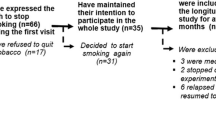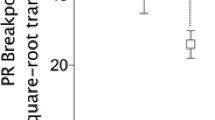Abstract
The present study examined the situation-specific effects of smoking using a paced regimen of smoking to control the smoke intake. The subjects were first required to sham smoke and then actually smoke one of their cigarettes in two different test contexts: 1) in the laboratory where they had never previously smoked and 2) at home, alone in a quiet room where they regularly smoke. Light (< 10 cigarettes/day) and heavy smokers (> 15 cigarettes/day) were studied to test for a possible effect of the paced regimen itself. In the light smokers, smoking produced a larger increase in heart rate (HR) in the laboratory than in the natural smoking environment; however, in the heavy smokers the smoking had a larger effect in the normal smoking environment than in the laboratory. There were no significant group or test situation differences for baseline HR, skin conductance and finger temperature. The groups also did not differ in the intensity of drawing on the cigarette or inhaling, as indicated by a puff sensor and a respiratory belt, respectively. It was concluded that differences between the effects of a cigarette in a laboratory setting and in a natural smoking environment may reflect pharmacodynamic effects of smoking that are modified by the subjects' prior experience with smoking. The data are discussed with regard to conditioned tolerance to the effect of smoking.
Similar content being viewed by others
References
Childress AR, McLellan TA, O'Brien CP (1986) Conditioned responses in a methadone population. J Subst Abuse Treat 3:173–179
Darby TD, McNamee JE, van Rossum JM (1984) Cigarette smoking pharmacokinetics and its relationship to smoking behaviour. Clin Pharmacokinet 9:435–449
Eikelboom R, Stewart J (1982) Conditioning of drug-induced physiological responses. Psychol Rev 89:507–528
Epstein LH, Caggiula AR, Stiller R (1989) Environment-specific tolerance to nicotine. Psychopharmacology 97:235–237
Epstein LH, Caggiula AR, Perkins KA, McKenzie SJ, Smith JA (1991) Conditioned tolerance to the heart rate effects of smoking. Pharmacol Biochem Behav 39:15–19
Glautier S, Remmington B (1995) The form of responses to drug cues. In: Drummond CD, Tiffany ST, Glautier S, Remmington B (eds) Addictive behaviour. Cue exposure theory and practice. Wiley, Chichester New York Brisbane Toronto Singapore, pp 21–46
Golding J, Mangan GL (1982) Arousing and de-arousing effects of cigarette smoking under conditions of stress and mild sensory isolation. Psychophysiology 19:449–456
Greeley J, Swift W, Heather N, (1982) Depressed effect as a predictor of increased desire for alcohol in current drinkers of alcohol. Br J Addict 87:1005–1012
Hasenfratz M, Thut G, Bättig K (1992) Twenty-four-hour monitoring of heart rate, motor activity and smoking behavior including comparisons between smokers and nonsmokers. Psychopharmacology 106:39–44
Hauser H, Schwarz BE, Roth G, Bickford R (1958) Electroencephalographic changes related to smoking. Electroencephalogr Clin Neurophysiol 10:576
Hodes RL, Cook EW, Lang PJ (1985) Individual differences in autonomic response: conditioned association or conditioned fear? Psychophysiology 22:545–560
Johanson C-E, Mattox A, Schuster CR (1995) Conditioned reinforcing effects of capsules associated with high versus low monetary payoff. Psychopharmacology 120:42–48
Kanof PD, Handelsman L, Aronson MJ, Ness R, Cochrane KJ, Rubinstein KJ (1992) Clinical characteristics of naloxone-precipitated withdrawal in human opioid-dependent subjects. J Pharmacol Exp Ther 260:355–363
Kiianmaa K, Numi M, Ashizawa T, Sinclair JD (1995) The effect of repeated administration of ethonol on the release of dopamine in the nucleus accumbens of the alcohol-preferring AA and alcohol-avoiding ANA rats. Soc Neuro Abstr 21:1703
Maltzman I, Smith MJ, Kantor W, Mandell MP (1971) Effects of stress on habituation of the orienting reflex. Exp Psychol 87:207–214
Mello NK, Mendelson JH (1970) Experimentally induced intoxication in alcoholics: a comparison between programed and spontaneous drinking. J Pharmacol Exp Ther 173:101–116
Morris PH, Gale A (1994) Is sham smoking an adequate control condition for the motoric component of smoking? Addict Behav 19:393–400
Mucha RF (1991) What is learned during opiate withdrawal conditioning? Evidence for a cue avoidance model. Psychopharmacology 104:391–396
Mucha RF, Mutz G, Stephan E, Pauli P (1996) Smoking produces a smaller increase in heart rate in the natural smoking environment than in the laboratory. Drug Alcohol Depend (in press)
Ossip-Klein DJ, Martin JE, Lomax BD, Prue DM, Davis CJ (1983) Assessment of smoking topography generalization accross laboratory, clinical, and naturalistic settings. Addict Behav 8:11–17
Pauli P, Rau H, Zhuang P, Brody S, Birbaumer N (1993) Effects of smoking on thermal pain threshold in deprived and minimally-deprived habitual smokers. Psychopharmacology 111:472–476
Perkins KA (1995) Individual variability in responses to nicotine. Behav Genet 25:119–132
Pickens RW, Gust SW, Catchings PM, Svikis DS (1983) Measurement of some topographical aspects of smoking in the natural environment. NIDA Res Monogr 48:62–78
Siegel (1975) Evidence from rats that morphine tolerance is a learned response. J Comp Physiol Psychol 89:498–506
Spealman RD (1979) Bhavior maintained by termination of a schedule of self-administered cocaine. Science 204:1231–1233
Steiner SS, Beer B, Shaffer MM (1969) Escape from self-produced rates of brain stimulation. Science 163:90–91
Tiffany ST (1990) A cognitive model of drug urges and drug-use behaviour: role of automatic and non automatic processes. Psychol Rev 97:147–168
Warburton DM (1994) Psychological resources from nicotine. J Smok Relat Dis 5 [Suppl. 1]:149–155
Author information
Authors and Affiliations
Rights and permissions
About this article
Cite this article
Schupp, P.E., Mucha, R.F. & Pauli, P. Paced smoking in the laboratory and in the natural smoking setting: differential situation-specific effects in light and heavy smokers. Psychopharmacology 127, 283–288 (1996). https://doi.org/10.1007/BF02246137
Received:
Revised:
Issue Date:
DOI: https://doi.org/10.1007/BF02246137




